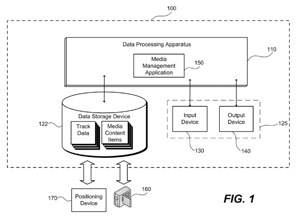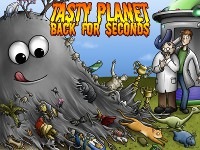Apple is working on even more ways to associate media content items with geographical data, per a new patent (number 20110148936) at the US Patent & Trademark Office. It relates to presenting digital media, for example, digital photographs, digital video, and the like.
Systems and techniques are disclosed for associating and presenting media content items with locations on a geographical track path. For example, the frames of a video segment can be associated with locations on a track path. The track path can be based on position data, including position coordinates and a corresponding time coordinates, obtained while the video frames were captured.
Locations for the video frames can be determined based on a start time of the video segment, a frame rate of the video segment, and the position data. The video segment can be displayed with user controls that enable a user to manipulate the frame of the video segment being displayed including a time indicator and a location indicator displayed on the track path. Nikhil Bhatt is the inventor.
Here’s Apple’s background and summary of the invention: “Digital photography and digital videography have simplified taking, viewing, storing, and reproducing media content such as still images and video. Photographs can be taken either using high-end equipment such as digital single lens reflex (SLR) cameras, low resolution cameras including point-and-shoot cameras and cellular telephone devices with suitable capabilities.
“Video can be taken either using high-end professional equipment, hand held cameras such as a camcorders, digital video cameras, and cellular telephone devices with suitable capabilities. Photographs and video can be transferred from one location to another location such as from one data storage device to another data storage device, or from one location on a data storage device to another location on a data storage device.
“Software applications can be used to store, display, and edit digital media content obtained from a camera, video camera, or any other electronic image in a digital format. Such software applications provide a user in possession of a large repository of digital media content with the capabilities to organize, view, and edit photographs and video
“This document describes systems, methods, and techniques for associating and presenting media content items with locations on a geographical track path. For example, a geographical track path can be determined based on geographical track data (position coordinates and time coordinates) obtained, for example, from a global positioning system (“GPS”) tracking device while the media content items were captured. The media content items can be associated with locations along the track path based on the times of capture of the respective media content items. A presentation can be displayed, in a user interface, of the media content items in a series based on their associated locations on the track path.
“User controls, including a location marker and a time marker, can be provided in the user interface that enable a user to manipulate the presentation. As the presentation is displayed, the location marker is displayed on the track path and represents a location of capture on the track path of a media content item being displayed in the presentation. The time marker is also displayed and indicates a time in the presentation corresponding to the media content being displayed.
“Manipulation of the location marker to a different location on the track path causes the media content item displayed in the user interface to change to a different media content item, i.e. a media content item captured at the different location, and causes the time marker to also change to a time in the presentation corresponding to the different media content item.
“Also, manipulation of the time marker to a particular time in the presentation causes the media content item displayed in the user interface to change to a different media content item that corresponds to the that particular time in the presentation and causes the location marker to move to a location along the track path associated with the location of capture of the different media content item.
“In some examples, frames of a video segment can be associated with corresponding locations on a geographical track path. The track path is based on track data, for example, obtained from a GPS tracking device while the video segment was being captured with a video camera. A location on the track path for each of the frames can be determined by interpolating a position on the track path for a date and time of capture of a reference frame (e.g. the start frame) in the video segment. From the reference frame and its location on the track path, a location on the track path can be interpolated for the other frames based on the frame rate of the video camera.
“The video segment can be displayed in a video window while the track path for the video segment is displayed on a map with a marker that represents the location on the track path of the frame being displayed. The marker moves along the track path as the video segment is played. The marker also moves along the track path as a user seeks through the video segment by manipulating, for example, a time marker associated with a frame time in the video segment.
“Also, the location marker can be moved to a different location on the track path, which in turn causes the frame being displayed to change to a different frame, a frame that was captured at the different location, and causes the time marker to change to a frame time associated with the different frame. The different location can converted into a frame time based on the track data, the reference frame of the video segment, and a frame rate of the video segment.”
Another new Apple patent (number 20110154309) for a compiler with energy consumption profiling has appeared at the US Patent & Trademark Office. It’s for an energy based framework is disclosed that allows a software compiler or developer to make decisions between performance and energy consumption. In one aspect, a first program code (e.g., vector engine based computation) may alternatively be compiled into a second program code (e.g., register operations).
Using measurements obtained from a processor for which the first and second program codes are being compiled, and the expected size of the data and a number of iterations, a comparison can be made between the expected energy consumption profile of the first program code and the equivalent second program code. Based on the comparison, a software developer or the compiler can choose the program code that minimizes energy consumption. The inventors are Ali Sazegari and Charles Randolph Overbeck.
— Dennis Sellers




